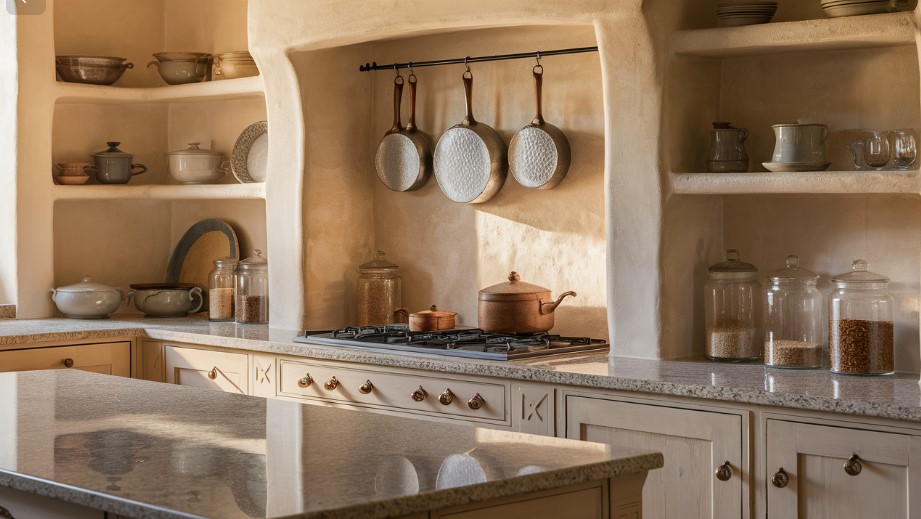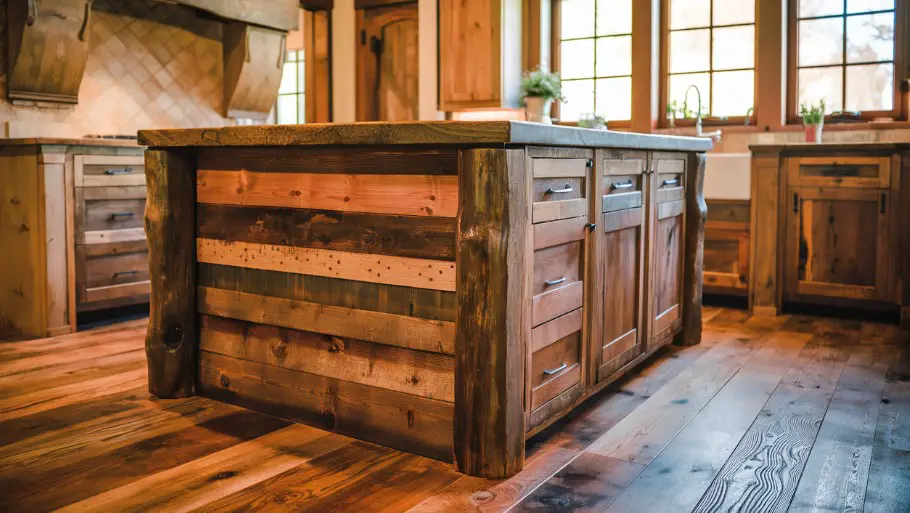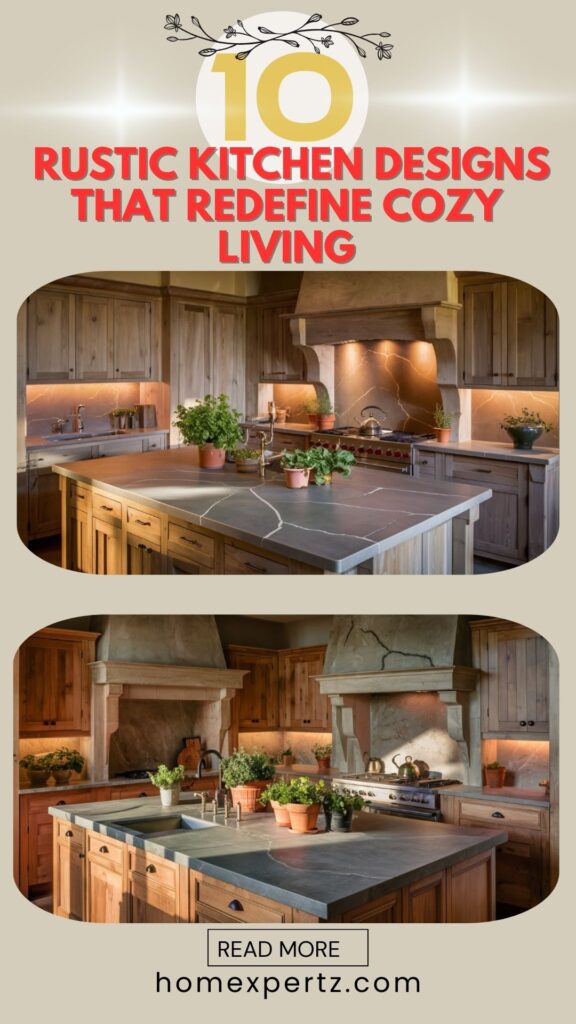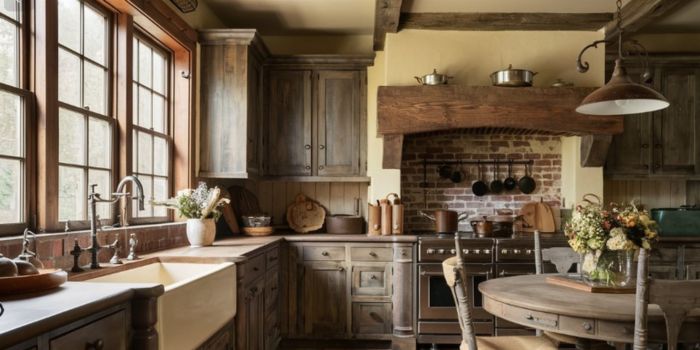Welcome to the world of rustic kitchen design, where timeless charm meets modern functionality. Imagine stepping into a space that feels both inviting and nostalgic, with warm wooden tones, textured surfaces, and an array of vintage-inspired details.
Rustic kitchens are more than just a cooking area; they’re a retreat from the hustle and bustle, offering a cozy and intimate atmosphere perfect for family gatherings and culinary adventures. From reclaimed wood cabinetry to farmhouse sinks and antique fixtures, this design style beautifully blends old-world aesthetics with contemporary comforts.
Ready to transform your kitchen into a rustic haven? Dive into our full blog post to explore inspiring ideas, practical tips, and creative solutions for bringing rustic elegance into your home. Read on to discover how to create a kitchen that’s not only functional but also a charming centerpiece of your living space.
Benefits of Rustic Kitchen Design

1. Timeless and Cozy Aesthetic
Rustic kitchen design has a warm, inviting, and timeless appeal that creates a cozy atmosphere in the heart of the home. The use of natural materials like wood, stone, and exposed beams evokes a sense of comfort and tradition.
2. Durable and Low-Maintenance
Rustic kitchens often feature durable materials that are easy to clean and maintain, such as tile, stone, and solid wood surfaces. This makes them ideal for busy families and high-traffic areas.
3. Flexibility and Customization
Rustic design allows for a great deal of flexibility and customization. You can mix and match different materials, textures, and finishes to create a unique look that reflects your personal style and the character of your home.
4. Increased Home Value
Rustic kitchens are highly desirable and can increase the value of your home. They appeal to a wide range of buyers who appreciate the charm and character of a well-designed rustic space.
5. Sustainability and Eco-Friendliness
Many rustic design elements, such as reclaimed wood and natural stone, are eco-friendly and sustainable. This aligns with the growing trend towards more environmentally conscious living.
6. Versatility and Adaptability
Rustic kitchens can be adapted to suit a variety of home styles, from farmhouses to modern lofts. They can also be scaled up or down to fit different kitchen sizes and layouts.
7. Emphasis on Craftsmanship and Quality
Rustic design celebrates craftsmanship and quality materials. The use of handcrafted elements and natural finishes adds depth and character to the space.
8. Promotes Relaxation and Stress Relief
The warm, inviting atmosphere of a rustic kitchen can help to promote relaxation and reduce stress. It’s a space where you can unwind and enjoy the simple pleasures of cooking and gathering with loved ones.
10 Key Ideas for Designing a Rustic Kitchen
1. Use Natural Materials

In rustic kitchen design, natural materials play a crucial role in creating a warm, earthy ambiance. Reclaimed wood can be used for cabinetry, flooring, or exposed beams, adding character and a sense of history.
Stone elements, such as backsplashes or countertops, contribute to a rugged, natural aesthetic and can range from sleek granite to rough-hewn slate. Copper cookware and fixtures introduce a rich, warm tone, enhancing the cozy, inviting atmosphere.
These materials not only add visual interest but also bring durability and a tactile connection to nature, making the kitchen a welcoming and grounded space.
2. Embrace Texture

Embracing texture is key in rustic kitchen design. Start with smooth countertops, which provide a sleek, practical surface. Pair these with rough-hewn wood elements, such as reclaimed wood beams or distressed cabinetry, to introduce a natural, rugged charm.
Incorporate hammered metal accents—like light fixtures, cabinet hardware, or a farmhouse sink—for a touch of vintage appeal. This blend of textures creates a dynamic visual contrast, adding depth and character.
The combination of smooth, rough, and textured surfaces fosters a warm, lived-in atmosphere, making the kitchen feel cozy and inviting. By layering different materials, you achieve a balanced, aesthetically pleasing rustic design.
3. Opt for Rustic Cabinetry

To achieve a rustic kitchen design, opt for cabinetry that showcases a distressed or weathered finish. Shaker-style or raised-panel doors are ideal choices, offering a timeless appeal that complements the rustic aesthetic.
These styles provide a sturdy, classic look with clean lines and simple elegance. The distressed finish adds character and a sense of history, making the kitchen feel cozy and lived-in. You can further enhance this look by choosing natural wood tones or muted, earthy colors.
Incorporate hardware with a vintage or antique finish, such as wrought iron or aged brass, to complete the farmhouse-inspired appearance. This combination creates a warm and inviting space that embodies the charm and simplicity of rustic design.
4. Incorporate Vintage and Antique Accents

To create a rustic kitchen with character and history, incorporate vintage and antique accents. Choose vintage lighting fixtures like industrial pendants or farmhouse chandeliers to evoke a nostalgic charm.
Integrate antique furniture pieces, such as a weathered farmhouse table or a reclaimed wood island, which provide both function and rustic appeal. Use salvaged decor items, like old signs, vintage scales, or antique jars, to add unique touches and a sense of history.
These elements combine to create a warm, inviting kitchen with a rich, lived-in feel, blending the old with the new for a timeless aesthetic.
5. Utilize Open Shelving

Utilizing open shelving in a rustic kitchen design allows you to showcase your collection of rustic pottery, cookbooks, and decorative items, enhancing the kitchen’s warm, inviting atmosphere.
This design choice highlights the natural beauty and craftsmanship of your kitchenware, making them part of the decor. It also provides easy access to frequently used items, adding practicality to the aesthetic appeal.
To maximize the rustic charm, opt for shelves made from reclaimed wood or distressed materials, and mix in elements like woven baskets and vintage jars. This approach not only adds character but also creates a sense of homeliness and authenticity, inviting guests to feel comfortable and at ease in your kitchen.
6. Add Rustic Hardware:

To enhance the rustic charm of your kitchen, incorporate hardware with a time-worn appearance. Opt for aged bronze, wrought iron, or oil-rubbed finishes on your cabinet and drawer pulls. These materials evoke a sense of history and craftsmanship, aligning perfectly with a rustic aesthetic.
Aged bronze offers a warm, antique look, while wrought iron adds a sturdy, handcrafted feel. Oil-rubbed hardware presents a slightly worn, vintage appearance. These finishes not only add character but also create a cohesive, nostalgic ambiance in your kitchen, seamlessly blending with other rustic elements like wooden beams, stone accents, and distressed cabinetry.
7. Highlight Natural Stone

Highlighting natural stone in a rustic kitchen design involves incorporating elements like soapstone, granite, or marble countertops. These materials not only add durability and functionality but also introduce an organic, timeless aesthetic.
Soapstone offers a smooth, matte finish that darkens over time, enhancing the kitchen’s rustic charm. Granite, with its unique patterns and colors, adds a touch of elegance while remaining resilient to heat and scratches.
Marble provides a classic, luxurious look, though it requires more maintenance. Using these stones can create focal points, complement wooden cabinetry, and add texture, enhancing the overall earthy, warm ambiance typical of rustic kitchens.
8. Incorporate Farmhouse Sinks

Incorporating farmhouse sinks into a rustic kitchen design adds instant charm and practicality. These sinks, typically made of cast iron or featuring an apron-front style, are not only visually appealing but also highly functional.
The deep basin accommodates large pots and pans, making it ideal for busy kitchens. The classic, robust design aligns perfectly with rustic aesthetics, emphasizing simplicity and durability. Additionally, the exposed front of the apron-style sink enhances the kitchen’s vintage appeal.
Pairing the sink with traditional, weathered materials like reclaimed wood or distressed cabinetry can further enhance the rustic feel, creating a warm and inviting space that exudes timeless country charm.
9. Use Reclaimed Wood

In rustic kitchen design, using reclaimed wood is key to achieving an authentic, warm atmosphere. Reclaimed wood beams can add structural interest, highlighting the kitchen’s architectural charm.
They bring a sense of history and craftsmanship, often with unique textures and patinas that new wood lacks. Reclaimed wood floors not only offer durability but also enrich the space with natural beauty, showcasing knots, grains, and aged tones that enhance the rustic aesthetic.
A custom-built island crafted from reclaimed wood becomes a focal point, blending functionality with rustic style. It serves as a gathering spot while embodying sustainability, as reclaimed wood reduces environmental impact by repurposing materials.
This approach not only adds character but also aligns with eco-conscious design principles, making the kitchen both inviting and environmentally friendly. Integrating reclaimed wood in these ways ensures a rustic kitchen that is both timeless and environmentally responsible, appealing to those seeking authenticity and warmth in their home spaces.
10. Embrace Rustic Lighting

Embracing rustic lighting in your kitchen involves selecting pendant lights that evoke a vintage or industrial feel, such as those featuring Edison bulbs or wrought iron fixtures. These elements not only illuminate the space but also contribute significantly to the rustic ambiance by casting warm, inviting light and adding texture to the overall design.
Opt for fixtures with distressed finishes or natural materials like wood and metal to enhance the rustic charm further. Place these pendant lights strategically over key areas like the kitchen island or dining nook to create focal points and enhance the cozy, welcoming atmosphere typical of rustic kitchen designs.
The combination of antique-style bulbs and rugged materials ensures your kitchen lighting not only serves its functional purpose but also becomes a distinctive feature that complements the natural, earthy tones often found in rustic interiors.
Frequently Asked Questions
What defines a rustic kitchen style? Rustic kitchen style is characterized by natural materials, such as wood and stone, along with a warm, cozy atmosphere. It often features exposed beams, distressed finishes, and a connection to nature through elements like reclaimed wood or vintage accents.
What are popular color schemes for rustic kitchens? Earth tones are commonly used in rustic kitchens, including shades of brown, beige, and gray. Warm colors like terra cotta, deep greens, and muted blues can also complement the rustic aesthetic. White and off-white shades are often used to brighten up the space.
What materials are ideal for a rustic kitchen? Natural materials like wood (especially reclaimed or distressed wood), stone (such as granite or slate), and metals (like wrought iron or copper) are staples of rustic kitchen design. These materials add texture and authenticity to the space.
What kind of cabinetry suits a rustic kitchen? Rustic kitchen cabinets often feature distressed finishes, beadboard accents, or open shelving to showcase rustic dishware or décor. Wood species like oak, maple, or pine are popular choices, sometimes with visible grain patterns.
How can I enhance the rustic feel of my kitchen without renovating? You can achieve a rustic look through décor and accessories. Incorporate items like woven baskets, Mason jars, vintage signage, or farmhouse-style lighting fixtures. Adding rustic textiles such as checked or floral patterns can also contribute to the overall theme.
Conclusion
Rustic kitchen design offers a charming blend of warmth and functionality, making it ideal for small spaces seeking a cozy, inviting atmosphere. Emphasizing natural materials like wood and stone, rustic kitchens often feature exposed beams, distressed finishes, and vintage elements that evoke a sense of timeless comfort.
In smaller kitchens, this style can maximize efficiency by incorporating open shelving, multi-functional furniture, and clever storage solutions disguised within the rustic aesthetic. By focusing on earthy tones and textures, such as reclaimed wood and wrought iron accents, rustic design creates a visually cohesive space that feels both intimate and practical.
Whether in a countryside cottage or an urban apartment, embracing rustic elements allows for personalization through curated decor and a focus on handmade craftsmanship, ensuring every inch of the kitchen reflects a welcoming and enduring appeal.

